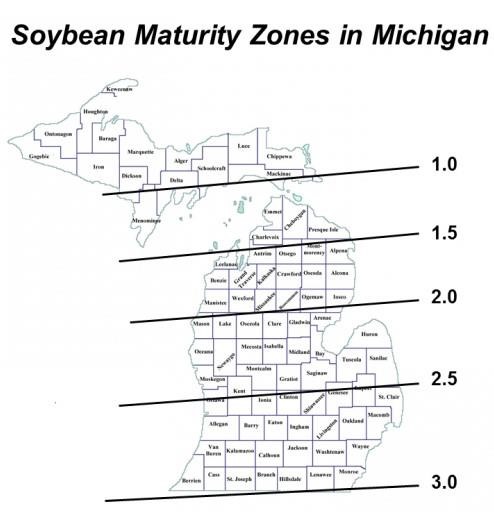By Michael Staton
Planting double crop soybeans is generally not recommended in Michigan due to the high risk associated with this practice. However, there are producers in southwest Michigan that raise double crop soybeans successfully. Being able to apply irrigation water significantly improves the probability of success. Double crop soybean yields range from 0 to 30 bushels per acre depending on planting date, available soil moisture and the date of the first killing frost in the fall.
Soil moisture is the most critical factor to consider as most double crop failures are caused by a lack of moisture. Both surface and subsurface moisture levels are important. If there is not enough moisture near the soil surface to germinate the seed, critical time and yield potential will be lost. If the subsoil is dry due to a lack of rainfall in June, the double crop soybeans will be totally dependent on rainfall for the remainder of the season and will probably fail to make a crop. “If June is dry, do not try” is a good quote to remember.
 Figure 1. Soybean maturity zones in Michigan. Adapted from Zhang, L.X, Kyei-Boahen,S, Zhang, J., Zhang, M.H., Freeland, T.B., Watson, C. E., Jr., and Liu, X.M. 2007. Modifications of optimum adaption zones for soybean maturity groups in the USA. Crop Management.
Figure 1. Soybean maturity zones in Michigan. Adapted from Zhang, L.X, Kyei-Boahen,S, Zhang, J., Zhang, M.H., Freeland, T.B., Watson, C. E., Jr., and Liu, X.M. 2007. Modifications of optimum adaption zones for soybean maturity groups in the USA. Crop Management.If you plan to plant soybeans after wheat harvest, following the management practices listed below will increase your probability for success.
- Understand and follow the rotation restrictions for all herbicides applied to the wheat crop.
- Harvest the wheat as soon as possible. Wheat can be harvested at 18 to 20 percent moisture without damaging the kernels and safely dried using natural air or low temperature drying systems. This will allow you to plant three to five days earlier.
- Chop or bale the straw. Chopped straw must be spread uniformly.
- Leave 8 to 10 inches of wheat stubble. This will force the soybean plants to set pods higher off the ground.
- Select varieties that are one half to one full maturity group earlier than the recommended full-season varieties for your area (Figure 1). For example, a producer in southern Berrien County should plant varieties from maturity groups 2.0 to 2.5. Avoid planting very early maturing varieties as the plants will be very short and yield poorly. Planting full-season varieties increases the potential for frost damage and delays harvest operations increasing the potential for creating harvest ruts (Photo 1).
- Choose tall, small-seeded varieties if possible.
- Plant as early as possible and always before July 10. At this time of the year, soybeans lose one bushel per acre of yield potential for each day planting is delayed.
- Plant with a no-till drill or planter into untilled wheat stubble to conserve soil moisture and save time.
- Plant in narrow rows (15 inches or less) and use high seeding rates (225,000 seeds per acres when planting with a drill and 180,000 seeds per acre when using a planter) to facilitate faster canopy closure and increase the height of the lowest pods.
- Select fields having few stones or consider rolling the fields after planting to reduce the potential for cutter bar damage when harvesting shorter plants.
- Select wheat fields that have received herbicide applications or have very little weed pressure.
- Never plant double crop soybeans in fields infested with soybean cyst nematodes.
- Control existing weeds at planting and have a strategy for controlling weeds in the crop.
Planting double crop soybeans is risky in Michigan, so try to reduce the cost of this enterprise. Also, be aware that planting double crop soybeans is adding another soybean crop to your rotation. This can decrease future soybean yields due to higher levels of soil-borne diseases and soybean cyst nematodes. Due to the projected shortage of livestock feed in the state, consider planting an annual forage crop instead of soybeans after wheat harvest in 2021.
Source : msu.edu